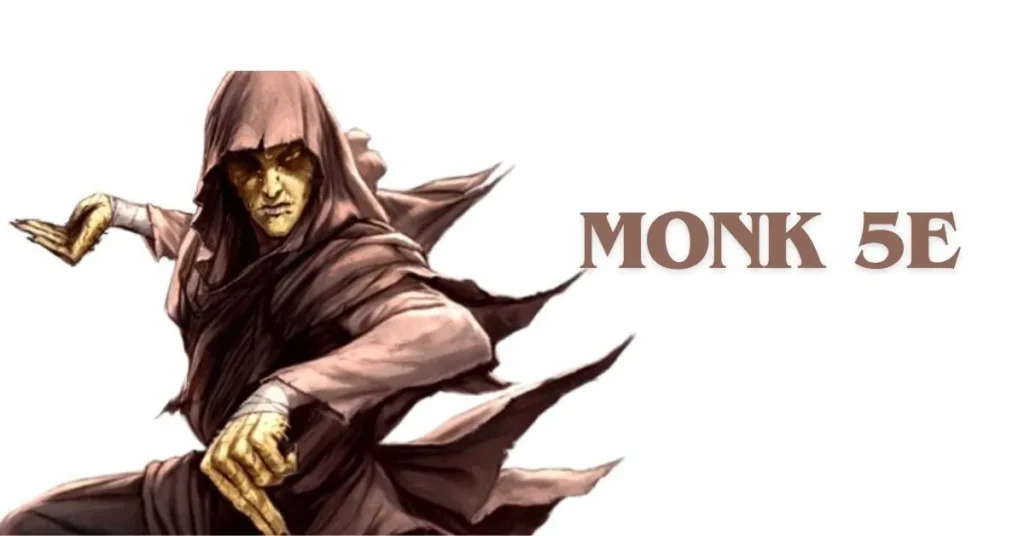If you’re diving into the world of Dungeons & Dragons 5th Edition (5E), you might be curious about playing a Monk. The Monk class is unique and intriguing, combining martial arts prowess with mystical abilities. In this guide, we’ll explore everything you need to know to create and play an effective Monk in 5E. Whether you’re new to the game or a seasoned player, there’s something here for you. So, let’s get started on mastering the Monk in 5E.
Why Play a Monk in 5E?
Monks in 5E are a versatile and dynamic class. They offer a blend of physical combat skills, speed, and mystical abilities that make them stand out. If you enjoy the idea of a character who can dart around the battlefield, deliver powerful unarmed strikes, and tap into a reservoir of spiritual energy, the Monk is an excellent choice.
One of the main appeals of playing a Monk is their mobility. With abilities like Unarmored Movement, Monks can move quickly and easily, making them hard to hit and great for positioning. Additionally, Monks have access to Ki, a resource they can use to perform special techniques and enhance their combat effectiveness.
Building Your Monk: Key Abilities and Skills
When building a Monk in 5E, it’s essential to focus on the right abilities and skills. The primary abilities for Monks are Dexterity and Wisdom. Dexterity increases your attack accuracy and damage, while Wisdom boosts your AC (Armor Class) when not wearing armor and enhances your Ki abilities.
Dexterity:
Dexterity is crucial for a Monk. It determines your attack rolls, damage with Monk weapons, and your AC. High Dexterity makes you a formidable combatant, able to strike accurately and dodge incoming attacks.
Wisdom:
Wisdom is the second most important ability for Monks. It improves your AC through Unarmored Defense and enhances your Ki abilities. A high Wisdom score means your Monk can better utilize their mystical powers and stay protected in combat.
Other Abilities:
While Dexterity and Wisdom are key, don’t neglect Constitution. A good Constitution score increases your hit points, allowing you to survive longer in combat. Strength can be useful but is not as crucial since Monks rely more on Dexterity.
The Monk’s Unique Abilities: Ki and Martial Arts
Monks in 5E have several unique abilities that set them apart from other classes. Understanding and utilizing these abilities effectively can make your Monk a powerhouse on the battlefield.
Ki Points:
Ki is the mystical energy that Monks harness to perform extraordinary feats. Starting at 2nd level, you gain a number of Ki points equal to your Monk level. These points can be used for various abilities, such as Flurry of Blows, Patient Defense, and Step of the Wind.
Flurry of Blows:
Flurry of Blows allows you to make two unarmed strikes as a bonus action after taking the Attack action. This ability increases your damage output and can overwhelm enemies with a flurry of attacks.
Patient Defense:
By spending 1 Ki point, you can take the Dodge action as a bonus action on your turn. This makes you harder to hit and can be a lifesaver in tough combat situations.
Step of the Wind:
Step of the Wind lets you spend 1 Ki point to take the Disengage or Dash action as a bonus action. Additionally, your jump distance is doubled. This ability enhances your mobility, allowing you to move around the battlefield with ease.
Martial Arts:
Monks excel in unarmed combat and can use simple weapons with great skill. Martial Arts provide several benefits:
- Unarmed Strike Damage: You can use Dexterity instead of Strength for your unarmed strikes and Monk weapon attacks. Your unarmed strike damage increases as you gain levels.
- Bonus Attack: When you take the Attack action with an unarmed strike or a Monk weapon, you can make one unarmed strike as a bonus action.
These abilities make Monks lethal in close combat and highly adaptable.
Monastic Traditions: Choosing Your Path
At 3rd level, Monks choose a Monastic Tradition, which shapes their abilities and playstyle. Each tradition offers unique features and abilities, allowing you to customize your Monk to fit your preferred style of play. Let’s explore some popular Monastic Traditions in 5E.
Way of the Open Hand:
The Way of the Open Hand focuses on mastery of unarmed combat. Monks following this tradition can manipulate their enemies’ bodies with precise strikes.
Open Hand Technique:
When you hit a creature with one of the attacks granted by your Flurry of Blows, you can impose one of the following effects:
- Knock Prone: The target must succeed on a Dexterity saving throw or be knocked prone.
- Push Away: The target must succeed on a Strength saving throw or be pushed up to 15 feet away from you.
- Prevent Reaction: The target can’t take reactions until the end of your next turn.
These abilities make the Open Hand Monk versatile in controlling the battlefield and disabling enemies.
Way of Shadow:
The Way of Shadow is perfect for those who want to play a stealthy, ninja-like Monk. This tradition focuses on deception, stealth, and subterfuge.
Shadow Arts:
Starting when you choose this tradition at 3rd level, you can use your Ki to duplicate the effects of certain spells. You can spend 2 Ki points to cast Darkness, Darkvision, Pass Without Trace, or Silence without providing material components. Additionally, you gain the Minor Illusion cantrip.
Shadow Step:
At 6th level, you gain the ability to step from one shadow into another. When you are in dim light or darkness, you can use a bonus action to teleport up to 60 feet to an unoccupied space you can see that is also in dim light or darkness. You then have advantage on the first melee attack you make before the end of the turn.
This makes the Shadow Monk a master of stealth and surprise attacks.
Way of the Four Elements:
If you love the idea of combining martial arts with elemental powers, the Way of the Four Elements is the path for you. This tradition allows you to manipulate the elements to attack and defend.
Elemental Disciplines:
When you choose this tradition at 3rd level, you learn magical disciplines that harness the power of the elements. You can spend Ki points to cast spells like Burning Hands, Thunderwave, and more. The list of available disciplines grows as you gain levels, offering a wide range of elemental abilities.
This tradition provides versatility, allowing you to adapt to various combat situations with elemental magic.
Strategies for Playing a Monk:
Playing a Monk in 5E involves more than just understanding your abilities. Effective strategies can help you make the most of your character and shine in your role. Here are some tips for playing a successful Monk.
Mobility and Positioning:
Monks are incredibly mobile, and you should leverage this to your advantage. Use your speed and abilities like Step of the Wind to position yourself effectively on the battlefield. Engage enemies where you can do the most damage while avoiding being surrounded or targeted by powerful attacks.
Managing Ki Points:
Your Ki points are a limited resource, so managing them wisely is crucial. Use them strategically to maximize your effectiveness in combat. For instance, Flurry of Blows can be a great way to deal extra damage, but sometimes it’s better to use Patient Defense to protect yourself or Step of the Wind to reposition.
Combining Abilities:
Combining your abilities can create powerful effects. For example, using Stunning Strike to incapacitate an enemy, then following up with Flurry of Blows to deal extra damage while they’re stunned. Experiment with different combinations to find what works best in various situations.
Advanced Monk Tactics:
As you gain experience playing a Monk, you can start incorporating more advanced tactics into your gameplay. These tactics will help you make the most of your Monk’s abilities and dominate the battlefield.
Stunning Strike:
Stunning Strike is one of the most powerful tools in a Monk’s arsenal. Starting at 5th level, when you hit another creature with a melee weapon attack, you can spend 1 Ki point to attempt a stunning strike. The target must succeed on a Constitution saving throw or be stunned until the end of your next turn.
Stunning an enemy can turn the tide of battle. A stunned opponent can’t move, attack, or cast spells, making them easy prey for you and your allies. Use this ability on high-priority targets like spellcasters and powerful melee fighters.
Ki-Empowered Strikes:
At 6th level, your unarmed strikes count as magical for the purpose of overcoming resistance and immunity to nonmagical attacks and damage. This means you can damage creatures that would otherwise shrug off your attacks, making you more effective against a wider range of enemies.
Evasion and Deflect Missiles:
Monks are incredibly agile and can avoid damage with abilities like Evasion and Deflect Missiles.
Evasion:
Starting at 7th level, you can nimbly dodge out of the way of certain area effects, such as a red dragon’s fiery breath or an Ice Storm spell. When you are subjected to an effect that allows you to make a Dexterity saving throw to take only half damage, you instead take no damage if you succeed on the saving throw and only half damage if you fail.
Deflect Missiles:
Starting at 3rd level, you can use your reaction to deflect or catch the missile when you are hit by a ranged weapon attack. When you do so, the damage you take from the attack is reduced by 1d10 + your Dexterity modifier + your Monk level. If you reduce the damage to 0, you can catch the missile if it is small enough for you to hold in one hand and you have at least one hand free. These abilities enhance your survivability, allowing you to stay in the fight longer and contribute more effectively.
Roleplaying Your Monk:
Roleplaying is a vital part of any D&D campaign, and Monks offer rich opportunities for character development and storytelling. When creating and playing your Monk, consider their background, motivations, and personality.
Background and Motivations:
Why did your character become a Monk? Did they join a monastery seeking enlightenment or to escape a troubled past? Are they on a quest for revenge, justice, or inner peace? Understanding your character’s background and motivations can add depth to your roleplaying and guide your actions in the game.
Personality and Quirks:
Every Monk is unique, and adding personality traits and quirks can make your character more memorable. Perhaps your Monk is disciplined and stoic, speaking little but acting decisively. Or maybe they have a mischievous side, enjoying pranks and riddles. Think about how your Monk interacts with others and what makes them stand out.
Monastic Code:
Many Monks follow a monastic code or philosophy. This could involve principles like non-violence, self-discipline, or the pursuit of knowledge. Your Monk’s code can influence their decisions and actions, providing a moral compass and adding complexity to their character.
Conclusion: Embracing the Monk’s Path
Playing a Monk 5E offers a unique and rewarding experience. With their blend of martial prowess, mystical abilities, and unparalleled mobility, Monks can be both powerful combatants and compelling characters. By understanding their key abilities, choosing the right Monastic Tradition, and employing effective strategies, you can master the Monk and make a significant impact in your campaign.
Remember, the most important aspect of playing a Monk—or any character in D&D—is to have fun. Embrace the Monk’s path, explore their potential, and enjoy the journey. Whether you’re darting across the battlefield, delivering flurries of powerful strikes, or delving into your character’s backstory, the Monk offers endless possibilities for adventure and storytelling.







